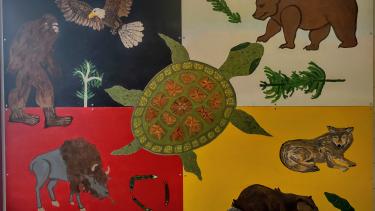Check Out the Awesome: Brent Kennedy Elementary

This year at Brent Kennedy Elementary, our school community is focusing on integrating Indigenous ways of knowing, being, histories, and perspectives into our everyday learning. Our school community has begun and will continue to integrate these teachings through storytelling, art, music, circle, and other traditional practices.
To guide our learning this year, we are using the seven sacred teachings to help us teach and learn in a good way. The Seven Sacred Teachings originate from the Seven Grandfather Teachings from the Anishinaabe people and have been adopted by many (but not all) First Nations, Métis and Inuit Peoples. The teachings focus on the relationships we have with all of creation and offer ways on how people should treat others. The seven teachings include:
- Love – represented by the eagle
- Respect – represented by the buffalo
- Honesty – represented by the sasquatch
- Truth – represented by the turtle
- Humility – represented by the wolf
- Wisdom – represented by the beaver
- Courage – represented by the bear.
Each animal/teaching helps teach us how we can live our lives respecting animals, people, and the environment – every living thing. It should be noted that these teachings may differ slightly between groups or cultures. The photo is of a mural done at LVR of the animal representations of the Seven Sacred Teachings.
Prior to Winter break, we had a special focus on building relationships in our school and classroom communities. One of the First Peoples Principles of Learning is that learning is holistic, reflexive, reflective, experiential, and relational (focused on connectedness, on reciprocal relationships and a sense of place). We focused on building relationships through shared laughter and celebration. These connections were fostered through the use of games and whole class sharing within a circle.
In the new year, some classes learnt about the observing and tracking of seasonal change. We learnt about the tracking of seasonal change through the moon cycles and seasonal rounds, two different tools used by multiple indigenous cultures across Canada. We read a story from the Haida Nation about the different names for the 13 full moons in a year and how those names are given because of what changes are observed in the natural world during that time. We also read about the 13 moons on Turtle’s back and how Turtle’s shell was used to keep track of the 13 moons and seasonal changes that happen in a year. When learning about seasonal rounds, the students had the opportunity to create their own seasonal rounds that represented the important events and changes that happen in their life each year.
Throughout February we have begun to explore the importance of storytelling and what it means to be a good storyteller. We read the story of “How the Raven Stole the Sun” from various authors and explored the history of oral storytelling and how stories may change depending on who is telling them. We talked about how to make stories fun to listen to and how to make others remember them by using voice and expression. We also began to write and share our own stories in class. As we have been practicing the skill of storytelling, we have realized that we are all already storytellers; we share what we learnt at school, we tell stories about what we do on the weekends, we all have many stories that we already tell. We are all storytellers.
In March we will be feasting as a school on bannock made by the Indigenous Academic Success teacher and the students. This will be an opportunity to share culture, food, community, and joy with one another as one whole community.

